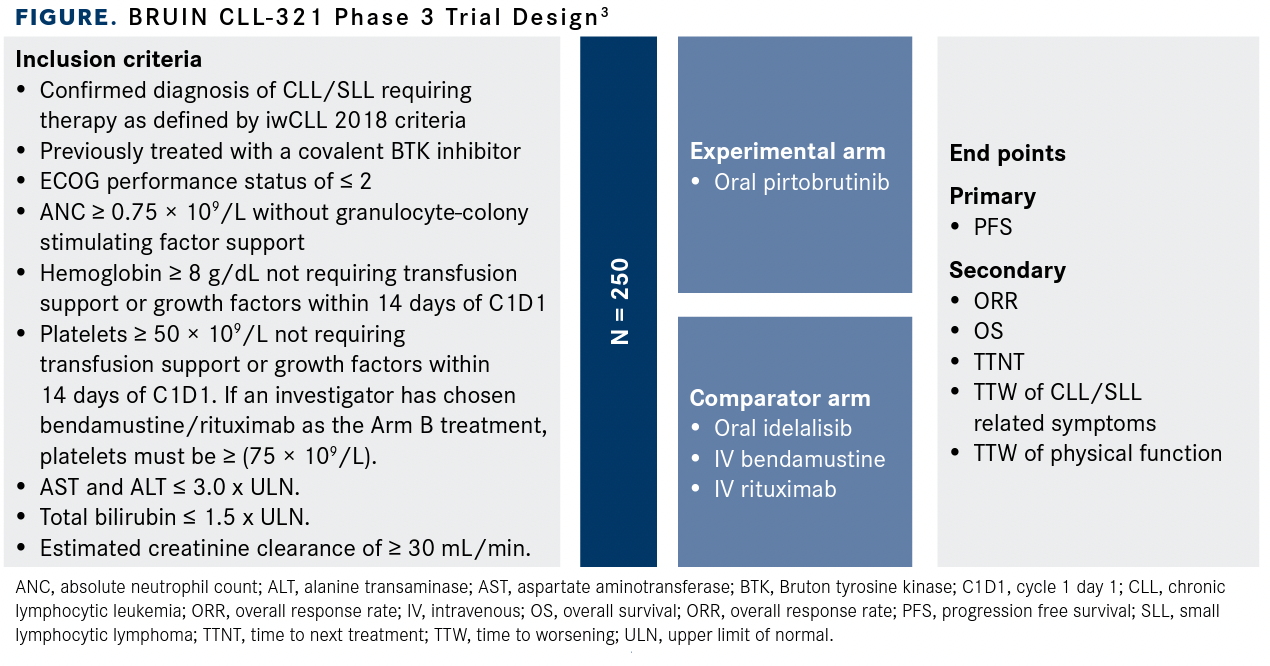Publication
Article
Oncology Live®
BRUIN CLL-321 Aims to Expand BTK Inhibitor Options in CLL/SLL
Author(s):
The BRUIN CLL-321 trial is evaluating pirtobrutinib monotherapy compared with investigator’s choice of idelalisib plus rituximab or bendamustine plus rituximab among patients with chronic lymphocytic leukemia or small lymphocytic lymphoma who have previously received covalent BTK inhibitor treatment.
John M. Burke, MD

Patients with relapsed or refractory chronic lymphocytic leukemia (CLL), small lymphocytic lymphoma (SLL), and other B-cell malignancies have previously achieved responses when treated with Bruton tyrosine kinase (BTK) inhibitors. However, these patients are often forced to discontinue treatment with these agents because of acquired resistance and safety concerns.1
“The initial therapy for patients with CLL used to be chemotherapy, then immunotherapy was added in the form of rituximab [Rituxan] and other monoclonal antibodies,” John M. Burke, MD, a hematologist and oncologist at Rocky Mountain Cancer Centers in Aurora, Colorado, said in an interview with OncologyLive®. “More recently, targeted therapies are providing for the most part better outcomes. One of these [effective therapies is] BTK inhibitors.”
Pirtobrutinib (previously LOXO 305) is an investigational, highly selective, and noncovalent BTK inhibitor that possesses high oral bioavailability and a long half-life, which leads to a high level of BTK target coverage independent of high BTK protein turnover.2
According to Burke, pirtobrutinib is unique among the BTK inhibitors available for the treatment of B-cell malignancies in that it is reversible in its binding to BTK, whereas other agents for B-cell malignancies bind to BTK via a covalent bond, also known as an irreversible bond.
“One of the mechanisms of resistance to [BTK inhibitors], the reason that CLL can become resistant to [BTK inhibitors], is that the BTK protein itself and the gene making BTK undergo a mutation,” Burke said. “That mutation leads to a protein that is in a way that the BTK inhibitors can no longer bind effectively to it. So, when the BTK inhibitor cannot bind to BTK anymore, the cancer escapes and can grow. Pirtobrutinib binds in a way that its binding is not affected by the presence of some of these mutations in BTK that are causing resistance to the other BTK inhibitor.”
Burke went on to say that partially because of this mechanism of action, pirtobrutinib has demonstrated efficacy in preclinical studies even when responses with other BTK inhibitors have tailed off. The phase 3 BRUIN CLL-321 trial (NCT04666038) seeks to capitalize on the previously observed efficacy of BTK inhibitors in patients with CLL or SLL, as well as the unique characteristics of pirtobrutinib in overcoming BTK inhibitor resistance. The trial is designed to evaluate the agent head to head with investigator’s choice of therapy.
Pirtobrutinib Monotherapy and Combinations Display Strong Efficacy
Initially, the phase 1/2 BRUIN study (NCT03740529) evaluated the safety and efficacy of pirtobrutinib as a monotherapy and in combination with multiple agents in patients with previously treated B-cell malignancies. Phase 1 consisted of pirtobrutinib monotherapy dose escalation and expansion parts with phase 1b evaluating pirtobrutinib as combination therapy dose expansion. The primary end point in phase 1 was the maximum-tolerated dose and in phase 2 was the overall response rate (ORR).1
A total of 323 patients with CLL, SLL, or non-Hodgkin lymphoma were treated with pirtobrutinib in phase 1. Pirtobrutinib was administered across 7 dose levels daily with linear dose-proportional exposures: 25 mg, 50 mg, 100 mg, 150 mg, 200 mg, 250 mg, and 300 mg.
Results from phase 1 showed that among 121 efficacy-evaluable patients with CLL or SLL who had previously been treated with a BTK inhibitor the ORR was 62% (95% CI, 53%-71%). Additionally, the ORR in patients with CLL who had developed previous covalent BTK inhibitor resistance (n = 79) was 67%, and 52% in patients with CLL and covalent BTK inhibitor intolerance (n = 42). Investigators determined the recommended phase 2 dose to 200 mg daily and the maximum-tolerated dose was not reached.
Regarding safety, no dose-limiting toxicities were reported; 5 patients had to discontinue treatment due to a treatment-related adverse effect (TRAE). Common AEs of any grade included fatigue (20%), diarrhea (17%), and contusion (13%). No instances of grade 3 atrial fibrillation or flutter were reported, and 1 patient experienced a grade 3 hemorrhage in the setting of mechanical trauma.
“[With] BTK inhibitors in general, the AEs of special interest are cardiac arrhythmias, particularly atrial fibrillation, and bleeding,” Burke said. “A very low number of patients are getting atrial fibrillation on pirtobrutinib and bleeding has been relatively minor. It appears that the tolerability of pirtobrutinib is great and the number of patients who [must] discontinue it due to AEs is very low.”
Updated data from the phase 1b portion of the BRUIN study, presented at the American Association for Cancer Research 2022 Annual Meeting, showed that pirtobrutinib plus venetoclax with or without rituximab was well tolerated with promising efficacy results. Among 22 efficacy-evaluable patients with relapsed/refractory CLL or SLL, the ORR was 95.5% (95% CI, 77%-100%) at the November 3, 2021, data cut-off date. The median duration of follow-up was 9 months (range, 3.9-15) and the median time to best response was 1.9 months (range, 1.6-5.4).2
In phase 1b, investigators randomly assigned adult patients with relapsed/refractory CLL or SLL to receive either pirtobrutinib plus venetoclax (n = 15; arm A) or pirtobrutinib plus venetoclax and rituximab (n = 10; arm B). In arm A, patients received pirtobrutinib 200 mg daily starting on day 1 of cycle 1, and venetoclax at a 5-week dose ramp up to 400 mg daily beginning on cycle 2, day 1. Patients in arm B were treated with rituximab 375 mg/m2 on day 1 of cycle 1, then 500 mg/m2 on the first day of cycles 2 to 6, pirtobrutinib 200 mg daily starting on day 3 of cycle 1, and venetoclax at a 5-week dose ramp up to 400 mg daily starting on cycle 2, day 1. Both arms had a cycle length of 28 days.
To be eligible for the phase 1b part of the study, patients needed to have an ECOG performance status of 2 or less and active disease in need of treatment. There was no requirement in terms of prior number of therapies and previous treatment with a BTK inhibitor was allowed; prior treatment with BCL2 inhibitors was not permitted. The key end points were safety and tolerability, pharmacokinetics, and the ORR of each combination.
Baseline patient characteristics were well balanced between the 2 arms; the median age in arm A was 66 years (range, 49-77) and 69 years (range, 39-78) in arm B. Most patients in both arms were male (87% and 70%, respectively). The median number of prior lines of systemic therapy was 1 (range, 1-2) in arm A and 2 (range, 1-4) in arm B. Common prior therapies in arm A and arm B included BTK inhibitors (73% and 60%, respectively), anti-CD20 antibodies (73% and 70%), and chemotherapy (53% and 60%).
In terms of safety, no patients in either arm experienced any dose-limiting toxicities and no patients had to discontinue treatment due to TRAEs. Investigators noted that the safety profile of both combinations were similar with no clear additive toxicities in patients with relapsed/refractory CLL.
In arm A, common treatment-emergent AEs (TEAEs) of any grade included fatigue (40%), nausea (40%), decreased neutrophil count (40%), and diarrhea (27%). Common grade 3/4 TEAEs were neutrophil count (40%), anemia (13%,) and diarrhea (7%). Common TRAEs of any grade included decreased neutrophil count (33%), fatigue (27%), and diarrhea (20%).
Similarly, in arm B, constipation (30%), diarrhea (30%), and infusion-related reactions (30%) were the most common TEAEs of any grade. Grade 3/4 TEAEs were rare and consisted of decreased neutrophil count (30%) and infusion-related reactions (10%), with 1 patient experiencing grade 4 decreased neutrophil count. TRAEs of any grade included increased lipase (20%), headache (10%), diarrhea (10%), and decreased neutrophil count (10%).
“Pirtobrutinib has a high level of activity in patients with CLL,” Burke said. “Those [response] rates seem to be increasing with longer duration of therapy. It clearly is an effective treatment and is a very well tolerated treatment without much in the way of serious AEs.”
Details of the BRUIN CLL-321 Trial
Considering the encouraging findings from phase 1b of the BRUIN study, investigators initiated the BRUIN CLL-321 trial, a randomized, open-label study evaluating pirtobrutinib monotherapy compared with investigator’s choice of idelalisib (Zydelig) plus rituximab or bendamustine (Bendeka) plus rituximab among patients with CLL or SLL who have previously received covalent BTK inhibitor treatment. Pirtobrutinib and idelalisib will be administered orally, whereas bendamustine and rituximab will be given intravenously.
Approximately 250 patients will be enrolled in the study. Patients will be randomly assigned 1:1 and will be stratified by prior venetoclax therapy and 17p deletion. If disease progression occurs, patients in the comparator arm may crossover to the experimental arm.
Eligible patients must have an ECOG performance score of 2 or less, an absolute neutrophil count of at least 0.75 × 109/L without granulocyte-colony stimulating factor support, and an estimated creatine clearance of at least 30 mL/ minute. Patients with ongoing drug-induced liver injury, significant cardiovascular disease, or prior exposure to a noncovalent BTK inhibitor will be excluded from the trial (FIGURE3).

Individuals with active uncontrolled autoimmune cytopenia, significant cardiovascular disease, active hepatitis B or hepatitis C infection are not eligible for enrollment.
The primary end point of the study is progression-free survival. Secondary end points, evaluated up to approximately 36 months, include ORR, overall survival, time to next treatment, time to worsening of CLL- or SLL-related symptoms, and time to worsening of physical function.
The trial is actively recruiting patients and the expected completion date is June 2024.
References
- Mato AR, Shah NN, Jurczak W, et al. Pirtobrutinib in relapsed or refractory B-cell malignancies (BRUIN): a phase 1/2 study. Lancet. 2021;397(10277):892-901. doi:10.1016/S0140-6736(21)00224-5
- Roeker LE, Mato AR, Brown JR, et al. Pirtobrutinib, a highly selective, non-covalent (reversible) BTK inhibitor in combination with venetoclax ± rituximab in relapsed/refractory chronic lymphocytic leukemia: results from the BRUIN phase 1b study. Presented at: American Association for Cancer Research 2022 Annual Meeting; April 8-13, 2022; New Orleans, LA. Accessed May 13, 2022. bit.ly/3FPtx9c
- Study of LOXO-305 versus investigator’s choice (IdelaR or BR) in patients with previously treated chronic lymphocytic leukemia (CLL)/small lymphocytic lymphoma (SLL) (BRUIN CLL-321). ClinicalTrials.gov. Updated April 29, 2022. Accessed May 15, 2022. https://clinicaltrials.gov/ct2/show/NCT04666038









